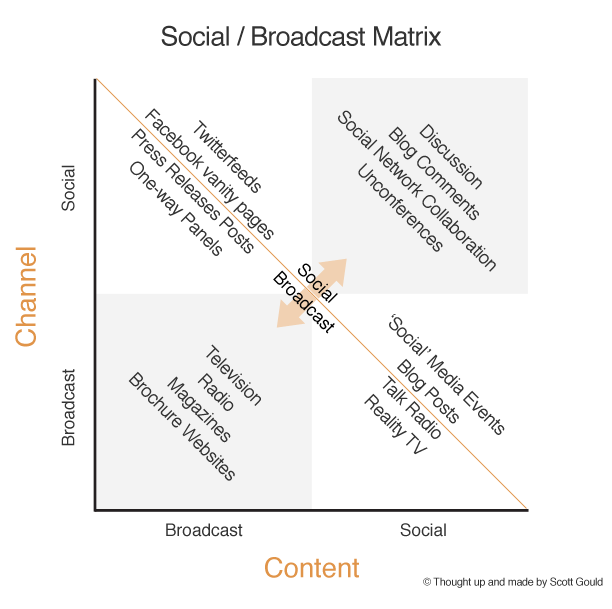
Being true to the form of curation, I’d like to point you to two great posts from this week. First is Loic LeMeur’s post on “The end of the traditional campaign = reach model“, in which he talks paid vs earned media and a few other things. What the post and his video both come down to is the misuse of terms and the confusion that is created by the melange of ideas around Social Media.
Next up is Olivier Blanchard’s follow up on Loic’s post, which in true Olivier fashion is entitled “What silly words say about people who use them“, and looks closer at some of the language and confusion that he have going on. One issue is with the idea of Social Media and Mobile being “emerging medias”, which Olivier deals with accordingly (“emerging” describes a state of adoption, not a type of media, and neither of their are emerging anymore, they are in mass adoption.)
Unfortunately, I’m not following up with a video, but I did want to remind us of the Social / Broadcast Matrix and how it helps us clarify media types, the language we use, and gives us a framework for understanding where we’ve come from and where we are going.
Social as a Consumer Mindset
The mindset that as a consumer, I have a say in media – by calling in, doing a phone vote, writing letters, the ability to be in the programme – has been a dominant consumer mindset for the last ten years now, especially since Reality TV exploded after the first Big Brother in 1999. This relates to the content of the media being social.
The most predominant social channels, the mobile phone and the internet, also gained such dominance around the same time, marking the 2000s as the turning point from broadcast to social as a mass consumer mindset.
As Olivier says, this is no longer emergent in adoption curve. With over 60% of the world using a mobile phone, and an estimate 20% of the world using Social Networking sites, multiway communication is well and truly adopted.
Clarifying Social
Social is the opposite of broadcast, and the product of a post-modern epistemology. In other words, our knowledge does not come in a top down format, where knowledge is pushed out to us from a single, absolute, one-way source that then forms our opinions and informs our lifestyle.
Instead, we have a web of knowledge – a multi-way structure were we are pulling information and pushing information out from various media nodes, each of us ourselves adapting this information as we receive and then re-emit it.
Example: the recent Leadership Debate in the UK General Election. As the three main parties were on TV, debating and doing what politicians do best, people were researching policies and checking facts on Google (see this) and debating the issues themselves on Twitter (see this). This would never happen under broadcast, and indeed, it couldn’t.
You know that I’ve written and spoken a lot about Spreadability vs Reach (there’s a Slideshare here, a framework here, and a case study here). The way I see it, a social mindset and Social Media thrive under a spreadability model. A broadcast mindset and Broadcast Media thrive under a reach model.
Your Leading Thoughts
I’ve only really presented a few ideas here and you’re expertise could flesh them out a lot more. If you’ve watched Olivier and Loic‘s videos, then I’m keen to know:
- How do you think paid and earned media as Loic describes fit into the Social / Broadcast Matrix, when we consider the effects of paying for Social Advocacy, like in the case of Loic’s Virgin Facebook Fan example?
- Where does Trust fit into this?
Archived Comments
-
http://radsmarts.com Robin Dickinson
I would suggest that your model could be 3D – a cube, with ‘trust’ as the Z axis, adding depth to every element proposed on your current 2D surface.
Just a thought.
Love the thinking.
Robin

-
/ Scott Gould
Hmmm – interesting. I do have a model already that I could add this into….. Will think it through…

Cheers mate.
-
sytaylor
You know what’s ironic. Newsnight reported the election debates as a “Fightback for broadcast television, one event everyone huddles around the tv for”.
I see it a little differently. The event was what everyone came to see, because it’s new, important and relevant. Yet outside that, as newsnight themselves reported, there are all kinds of conversations happening in real time during these debates. The debate was being broadcast, and at the same time; spread.
As per your diagram, it straddled the divide. To those in old media, it was a return to glory, to those is social media it was another event success like #iranelection. Which leads me to consider the possibility that neither are right. Broadcast has its place, and will probably never truly die. We will still have celebrities, and global phenomena with 100,000 million eyeballs watching the world cup final for example.
It’s just now, access to comment, or participate is based on your ability, and the value of your contribution. Previously, access to comment or participate was based on your position of influence. This itself, is a more subtle change, worth exploring.
-
/ Scott Gould
Sy you’re right – both Broadcast and Social exist and can co-exist. Neither is right or wrong – both have a place, both have different benefits, different pros and cons.
I love what you say here: “It’s just now, access to comment, or participate is based on your ability, and the value of your contribution. Previously, access to comment or participate was based on your position of influence.”
This for me is the essence of Social as a consumer mindset, and the essence of social authority. Given that possessions used to be the right to influence, then it became position as the right to influence, now it is.. participation?
Comments